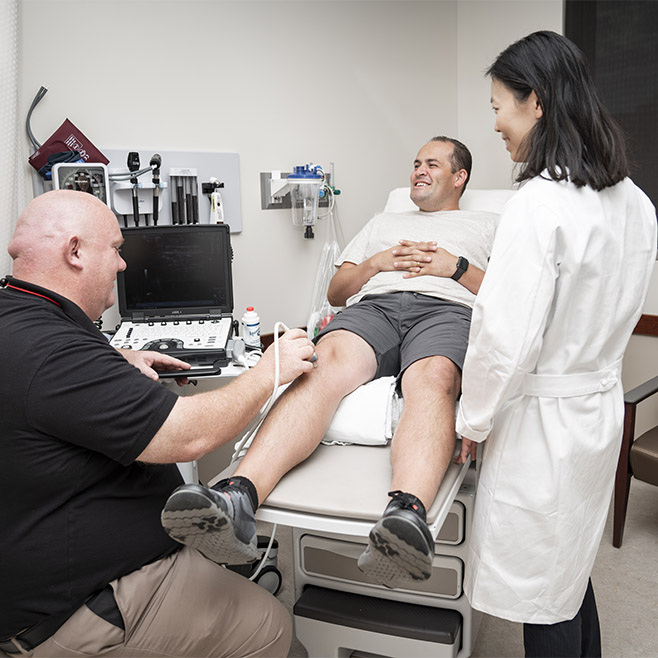
What Is Hemophilia?
Utah Center for Bleeding & Clotting Disorders Location
Sugar House Health Center
Fourth Floor
1280 E. Stringham Avenue
Salt Lake City, UT 84106
Hemophilia is a blood disorder in which a person is not able to clot normally. Proteins called clotting factors typically work together to form a clot whenever bleeding occurs. However, a person with hemophilia is either missing these proteins or does not make enough of the clotting factor, which prevents the blood from making clots. As a result, people with hemophilia will bleed for a longer period of time after an injury.
Types of Hemophilia
There are two main types of hemophilia:
- Type A — This occurs when a person is missing or has low levels of the blood clotting factor VIII (8).
- Type B — This occurs when a person is missing or has low levels of the blood clotting factor IX (9).
How Is Hemophilia Classified?
We classify hemophilia depending on the amount of clotting factor a person makes:
- Mild — A person with mild hemophilia may only have problems with bleeding when undergoing surgery, major dental work, or a severe injury.
- Moderate — A person with moderate hemophilia will experience bleeding associated with milder cases plus bleeding problems with minor injuries such as a hard bump to the knee.
- Severe — A person with severe hemophilia has less than one percent of the normal amount of clotting factor VIII (8) or factor IX (9). People without hemophilia have between 50-150 percent of the normal level of factor VIII (8) or IX (9). A person with severe hemophilia will have spontaneous bleeds (bleeding that starts inside the body for no known reason).
Symptoms of Hemophilia
Signs of hemophilia may vary from person to person depending on the severity of their hemophilia:
- Unexplained and excessive bleeding from injuries or after surgery or dental work
- Large or deep bruises
- Pain, swelling, or tightness in your joints
- Blood in your urine or stool
- Nosebleeds without a known cause
- Unexplained irritability (commonly in infants)
Hemophilia Causes
People with hemophilia are born with the disorder and have it for the rest of their lives. Hemophilia is a genetic disorder passed down generation to generation through a family's genes. This genetic defect occurs on the X chromosome, which means that women are carriers of hemophilia.
Hemophilia is far more common in men. In about one-third of the babies born with hemophilia, the disorder is believed to be caused by a spontaneous gene mutation when there is no family history of hemophilia. View more information at the Centers for Disease Control.
Find a Hematologist
Hemophilia Diagnosis
We will conduct blood tests to see if your blood is clotting properly. If it's not, we will do more blood tests that are specific to different types of bleeding disorders. These tests will tell us if you have normal, low, or no blood clotting factor in their blood.
Blood work is typically completed in conjunction with your first visit. Your blood will be drawn either in the exam room or in the lab following your visit. Some insurance carriers do not pay for labs to be done at University of Utah Health. If that is the case with your insurance, we will help you arrange labs at a location covered under your insurance provider.
How to Prepare for Your Appointment
Before you arrive to your appointment at the Utah Center for Bleeding & Clotting Disorders at U of U Health, please make sure your visit is covered under your insurance. If you have any questions about your coverage, call our office. Since we are the only hemophilia center for adults in Utah, most insurance companies work with our center to ensure patients are treated appropriately. Please send our office your past medical records to help the team understand your previous care and guide their decisions for future care.
What to Bring
Please bring the following to your appointment:
- Insurance card
- Medication history, including factor prescription
- Bleeding and dosing logs
- Pair of shorts for your physical assessment
- Any other items that might help us guide your treatment
Please arrive at least 20 minutes before your appointment to fill out pre-clinic paperwork.


What to Expect at Your First Appointment
As a team, we want your first appointment to run smoothly and provide you with quality education to help guide the treatment of your hemophilia diagnosis.
We treat hemophilia using a multidisciplinary team approach:
- Hematologist
- Nurse practitioner
- Nurse
- Physical therapist
- Social worker
- Pharmacist
- Genetic counselor
- Research coordinator
You will typically see each of these providers during your initial visit at our center. Clinic visits are often 1.5-2 hours in length. Please come with any questions, concerns, or issues written down to discuss with your provider.
Hemophilia Treatment
Need Surgery?
If you and your provider decide that surgery is the best treatment option, you will need to fill out a pre-surgery form. Please fill out the highlighted patient section on the last page of the form and send it back to your surgeon before your procedure. We require a 4-week notice to coordinate all elective surgeries and procedures.
We will tailor your treatment and care plan based on the following factors:
- Severity of hemophilia (e.g. mild, moderate, or severe)
- Types of activities you participate in
- Issues such as dental or other medical procedures needed
We often use injection therapy to stop excessive bleeding. We will inject you with the clotting factor that is missing from your blood. This injection can be self-administered at home or administered by a medical provider at a hospital or clinic.
Home Remedies to Stop Bleeding & Swelling
PRICE = Protection + Rest + Ice + Compression + Elevation
PRICE* is used as a general first aid treatment for joint or muscle bleeds or other injuries to help stop bleeding, manage swelling, and reduce pain. These recommendations are to be used in conjunction with blood clotting factor infusions as recommended by your medical provider.
PROTECTION — Limit your movements or keep weight off the affected area to prevent further injury and help stop bleeding. An arm sling, brace, or a splint will help support your arm or leg and limit movement. Assistive devices such as crutches or a walker will also help you decrease or prevent putting weight on a painful leg or foot.
If you don't have these items at home, contact the Utah Center for Bleeding & Clotting Disorders at U of U Health for recommendations.
REST — Stop using the affected arm or leg for 24 to 48 hours. However, you may need to limit activity for a few days or longer, depending on the site or severity of the injury or bleeding episode. Rest will help stop bleeding, manage pain, and limit swelling.
ICE — Apply ice/cold packs to the affected area (as needed) for 15 to 20 minutes every two to four hours for up to 48 hours or longer for more severe bleeds. This will help reduce your pain. Wrap a plastic bag of ice or cold packs in a thin cloth or paper towel to avoid direct contact on the skin.
COMPRESSION — This technique is used to reduce swelling and to help stop the bleeding. Wrap the affected area with an elastic bandage. Start wrapping below the area of swelling in an X-cross pattern, NOT in circular layers. The bandage should be snug, but loose enough to easily slide a finger under the wrap.
Muscle bleeds can put pressure on nerves and blood vessels which may require immediate medical intervention to prevent permanent damage.
DO NOT use an elastic bandage if you have:
- numbness or tingling,
- an increase in pain, or
- skin that feels cool below the site of swelling.
Call your medical provider immediately if you have any of these symptoms.
ELEVATION — Elevating an injury will help reduce and resolve swelling. Keep the injured leg or arm elevated (ideally above the level of your heart) as much as possible in the first 24 to 48 hours.
*This information was prepared and reviewed by the Western and Mountain States PT Working Group as a quality improvement initiative to standardize educational materials: Final-1/5/2017
References: GUIDELINES FOR THE MANAGEMENT OF HEMOPHILIA e31© 2012 Blackwell Publishing Ltd Haemophilia (2013), 19. PT PRACTICE GUIDELINES FOR PERSON’S WITH BLEEDING DISORDERS: Joint Bleeds/Muscle Bleeds, MASAC Document #204, National Hemophilia Foundation. Steps for living: Education for all Stages: https://stepsforliving.hemophilia.org/basics-of-bleeding-disorders/treatment-basics/prompt-treatment-is-important#firstaid (retrieved 10/05/2016)
Can Hemophilia Be Cured?
There is no approved cure for hemophilia at this time, but research is underway, such as studying gene therapy. People with hemophilia can expect to have a normal lifespan as long as they continue with their injection therapy and see a hematologist regularly.
Hemophilia Complications
Bleeding into the joints (such as the knees, elbows, and ankles) is a major problem for people with hemophilia. When this happens, your joint becomes swollen and painful. Repeated bleeding into a joint may cause a type of crippling arthritis. Bleeding inside other parts of the body (such as the brain, throat, and abdomen) can be life-threatening.
Make an Appointment
To make an appointment with one of our hematology specialists, you will need a referral from your physician. We also accept self-referrals; please fill out our online appointment request form.
Please check with your insurance carrier to make sure this appointment will be covered. In some cases, special permission has been given to our providers to see patients with out-of-network insurance.
Please call us at 801-213-8371 to schedule an appointment. We look forward to meeting you.
